How did a city with a population way smaller than Mumbai become the number 1 worst-hit COVID-19 metro in India? And what does it have to learn from its sex workers?
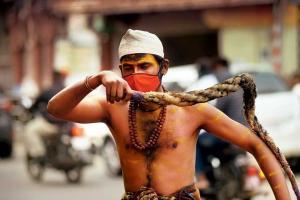
Mask firmly in place, a member of the Sholaga tribe lashes himself with a jute fibre whip to earn alms on the streets of Pune last week. Pic/ Atul Kamble
Last Wednesday, a tour of Pune's Budhwar Peth, Momin Pura, Bhawani Peth and Tadiwala Road areas revealed that joggers were out for their morning run, and locals were shopping for vegetables, many of them with no mask. Those who did, had them tucked under their chins. And, one pedestrian we crossed, spat before our feet. It was just another day in India.
Except, this is 2020; the country is deep in the throes of the Coronavirus pandemic. And Pune cannot afford to be lax.
Last month, Pune district, whose population as per the 2011 census was 94 lakh (Pune city registered 32 lakh), became the worst-affected district in Maharashtra. With over two lakh cumulative cases of COVID-19, it has surpassed Mumbai (1.30 lakh cases) and Delhi (1.93 lakh cases). And, matters are only getting worse.
On Saturday, the Maharashtra state health department reported that among the fresh cases in the state (22,000), Pune region led the charts with 6,232 cases even as Mumbai registered 2,321 cases. The death rate in the city stands at 2.81 per cent. As per data provided by the Pune Municipal Corporation (PMC), the total number of active cases on September 10 was 16,712, of which 7,745 were advised home isolation, 5,658 patients admitted to government and private hospitals and 3,309 admitted to Covid Care Centres (CCC).
So, how did Pune get here?

Devotees take home an idol of Lord Ganesha from Sadashiv Peth on August 21, the eve of Ganesh Chaturthi. Although Pune’s infection numbers have been consistently high, civic authorities told mid-day that lack of social distancing during the festival led to a marked spurt in cases in the city. PIC/Getty Images
The city saw its first COVID-19 case on March 9, when a couple returning from Dubai tested positive. Later, three others who had come in contact with the couple tested positive. By mid-August, Pune had overtaken Mumbai. PMC chief Vikram Kumar blames the rise of infections on the festive season. "There were a few cases during the lockdown. But, they started to increase during the Ganpati festival as people did not follow social distancing norms," he says.
Another factor, he believes is the inflow of infected people from nearby districts where citizens' faith in existing medical systems isn't high. "Pune is close to Ahmednagar, Satara, Sangli and Kolhapur, where COVID-19 cases are increasing quickly. Patients from adjacent cities are arriving here for better medical facilities and we cannot say no to them. Cases in Pune (rural) are also increasing. Nearly 30 per cent of total COVID-19 patients, undergoing treatment in Pune, belong to other cities," says Kumar, adding that increased testing has also led to an increase in number of cases.
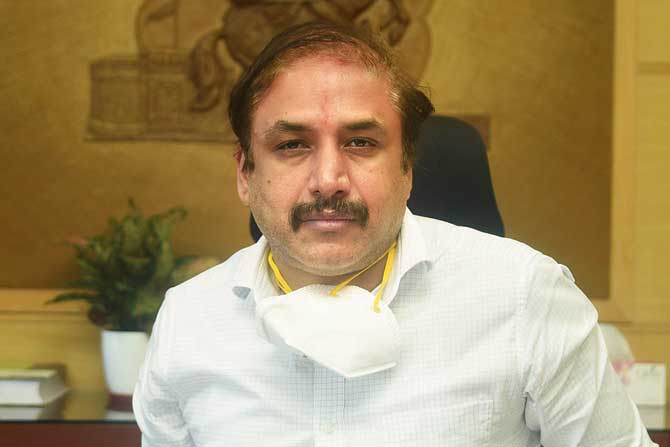
Vikram Kumar, Pune Municipal Corporation chief
"We have increased testing from 4,000 to 7,000 patients per day, the highest in Maharashtra. We have also set up 12 mobile vans to collect swabs from patients across the city. Every day at least 1,800 people are found COVID-19 positive. But, only 15 per cent of these need hospitalisation. The remaining are asymptomatic," he says.
But, there are those who argue that the city is ill-prepared to take care of its high caseload. Additional Municipal Commissioner (General) Rubal Agarwal admits that the PMC doesn't have enough manpower to run its first jumbo CCC, located at the College of Engineering Pune (CoEP), said to have been built at the cost of R200 crore. Equipped to operate with 800 beds, the PMC currently has manpower only for 200 beds. Efforts are on to fill the gap of 600 on priority. "Today, we have activated 80 beds, of which five each are meant for ICU and ventilator patients, whereas the remaining 70 beds are equipped with oxygen facility," she told mid-day in an interview on Friday, adding that the Pune Metropolitan Region Development Authority (PMRDA) has engaged an agency to hire doctors and other medical staff to run the jumbo CCC.
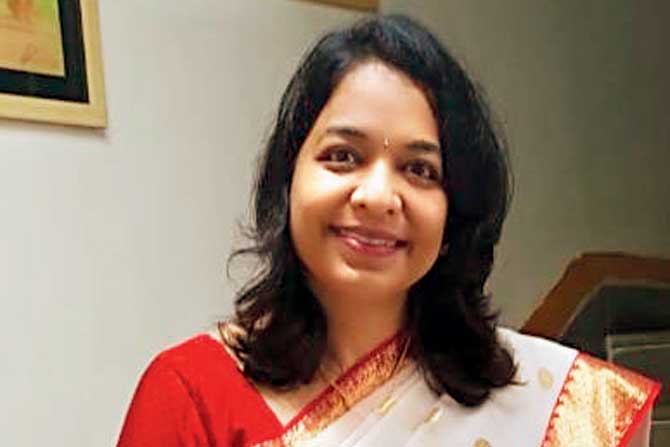
Rubal Agarwal, Additional Municipal Commissioner (General)
In addition to the CCC, Kumar says that more than 70 per cent of beds at private hospitals have been reserved for COVID-19 patients and all civic hospitals are now equipped with ICU beds.
Agarwal wants to urge people not to panic, as government bodies are working round-the-clock to contain the pandemic. "It is true that infections are on the rise, but with proper care and treatment, 83 per cent of people have recovered in Pune," Kumar adds that the civic body has also upped its contact tracing efforts, having created a control room in each ward. "Each control room makes at least 7,000 calls to asymptomatic people and their contacts to know their present health conditions. The positivity rate is at 26 per cent and the death rate is 2.81 per cent," he says.
While Agarwal has requested Punekars to reach out to the PMC helpline (020-26127398) or toll free number (1800-103-0222) for immediate medical assistance, residents say even basic ambulance facilities haven't been helpful. Kunal Gholap, 32, a mobile mechanic in Guruwar Peth, recalls the harrowing time he experienced when his 57-year-old father tested positive for COVID-19 on September 8. "I had called 108 for an ambulance, but no one arrived for 12 hours. Finally, I called a private ambulance and took him to Todkar hospital in Bhawani Peth, but the doctors asked me to deposit R30,000. Hospital charges would amount to an additional R15,000 per day. My father's condition was deteriorating, but I had no money for hospitalisation." By this time, his father's oxygen saturation level had dipped to 50. "I rushed him to Deenanath Mangeshkar Hospital where the doctors said they couldn't guarantee if he would survive. He was finally treated at Sardar Vallabhbai Patel Hospital where his condition is slowly improving," he narrates.

Rupali Patil-Thombare
This, feels former corporator Rupali Patil-Thombare, indicates a failure of state machinery.
"The government had blindfolds on and did little to control the pandemic," she says, adding, "They claim the cases increased after the Ganpati festival, but why were stringent measures not in place? What were the police and the PMC doing? Every day, 2,000 positive cases are reported, and most patients are advised home isolation because there's a dearth of beds in hospitals, and a lack of medical facilities," Thombare argues.
A round of containment zones, she says, is most likely to throw up blatant defying of rules, with people moving freely without masks.
A visit to Sangamwadi's Kailash Shamshan Bhoomi revealed that not only medical staff, crematorium workers are also reeling under the pressure of rising infections. Pune has a death rate of 2.4 per cent as opposed to Mumbai's 5 per cent.

Crematorium staff of Kailash Shamshan Bhoomi slip into PPE kits at the cremation chambers. They say they have to pull through an entire day in the same suit
There are two electric cremation chambers at Kailash Shamshan Bhoomi where on an average 32 bodies are burnt every day. Sources say that a staffer is given a single PPE suit to wear during an entire shift of eight hours. "During the initial days, we would dispose of a PPE suit after placing a body in the cremation chamber. Civic officials have said there is a shortage of PPE kits. We wear the same suit again and again. All we can do is sanitise our hands repeatedly," says Arif Shaikh, one of the four crematorium staffers. It takes around 1.5 hours for a body to be incinerated.
The crematorium's watchman Kanhaiya Salunkhe says the PMC has stopped providing hand sanitizer and soap for the staff who handle COVID-19 positive bodies. "Who cares about us? We are working here as a temporary staff whose salaries are delayed every month. We cannot dare to ask the senior officials as we fear losing our jobs," he adds. The rise in cremations means that families living in the area have had to face fell. A family of 50 members, who live in separate units around the crematorium, have been complaining of ash wafting into their bedrooms and kitchens.
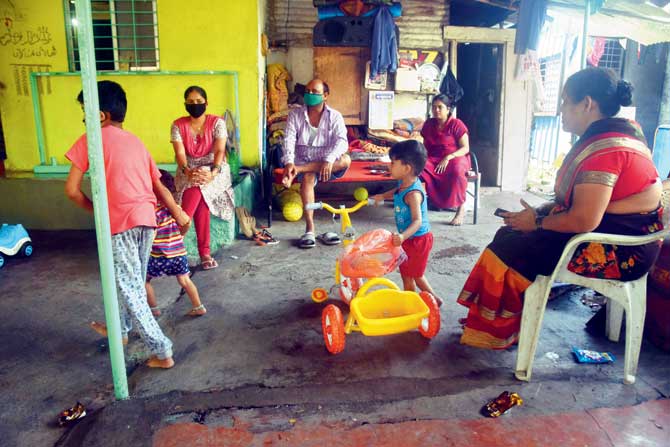
The Pardeshi family, which lives in the neighbourhood around Kailash Shamshan Bhoomi, where on an average 32 bodies are brought in daily, complain of ash settling on their food
Priti Pardeshi, 41, from the family, says, "The ash falls on our food. It's getting impossible to live here. The civic body is responsible for ensuring the living conditions here improve." Super Singh Pardeshi, 48, a security guard and resident of the neighbourhood, says he has had to shift his kitchen from the first floor to a narrow space on the ground floor, which is covered with asbestos and has no ventilation, to protect the food from contamination. He adds that those living nearby have left for their hometowns as they feared "inhalation of air contaminated by the smoke from the furnace."
With Nationalist Congress Party (NCP) chief and member of the coalition that's in power, Sharad Pawar, taking recent note of the downward spiral, efforts seem to be in place to make a change. The first step, say insiders, is to get people to get serious. In the two days, this reporter was in the city, police officers stationed at arterial roads were seen catching those not wearing masks.

Residents of Pune’s red-light area in Budhwar Peth have been following strict measures, with sex workers doing a temperature check, conducting sanitisation and refusing to entertain customers not wearing masks
Joint commissioner of police (Law and Order) Ravindra Shisve, says, "We are imposing a R500 fine for not wearing a mask. This drive started on September 2 and 22,773 people have been fined so far. We have collected more than R1.11 crore from offenders." Shisve says that a few rowdy people assaulted on-duty cops during the drive. "Three cases under Section 353 of IPC have been registered one each at Sahakar Nagar, Wanawadi and Koregaon Park police stations in Pune and the assaulters have been arrested," he adds.
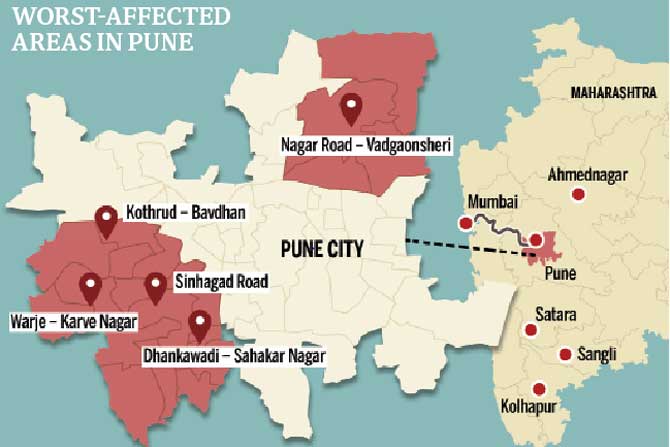
Map/Uday Mohite
Interestingly, Pune's greatest lesson in self-precaution may come from followers of the one profession that has little place for social distancing: its red-light area. Civic authorities say it's free from infections because of the precautions taken by commercial sex workers. "The footfall has decreased by 90 per cent due after the outbreak. We barely get a couple of customers in a day. However, they are all subjected to temperature checks before their entire body is sanitised, not just their hands. We want to ensure we do not get infected," says a sex worker from Budhwar Peth area.

The mid-day photographer captures a man spitting on the road from his car. The Pune police have upped their drive against those not wearing masks and following rules. More than 22,773 people have been fined and R1.11 crore collected. PICS/ATUL KAMBLE
Most sex workers say they do not entertain mask-less customers. Some have installed the Arogya Setu application on their phones to confirm if their customers are COVID-19 negative. Regular announcements to follow extra precautions are being made throughout the area. After all, as Alka Gunjal, group co-ordinator at PMC, says, contact tracing will prove problematic if a sex worker tests positive. "Though there are several cases of COVID-19 in Budhwar Peth, the red-light area has remained unaffected by the virus as the sex workers have been taking utmost precautions," she adds.
Keep scrolling to read more news
Catch up on all the latest Mumbai news, crime news, current affairs, and a complete guide from food to things to do and events across Mumbai. Also download the new mid-day Android and iOS apps to get latest updates.
Mid-Day is now on Telegram. Click here to join our channel (@middayinfomedialtd) and stay updated with the latest news
 Subscribe today by clicking the link and stay updated with the latest news!" Click here!
Subscribe today by clicking the link and stay updated with the latest news!" Click here!









